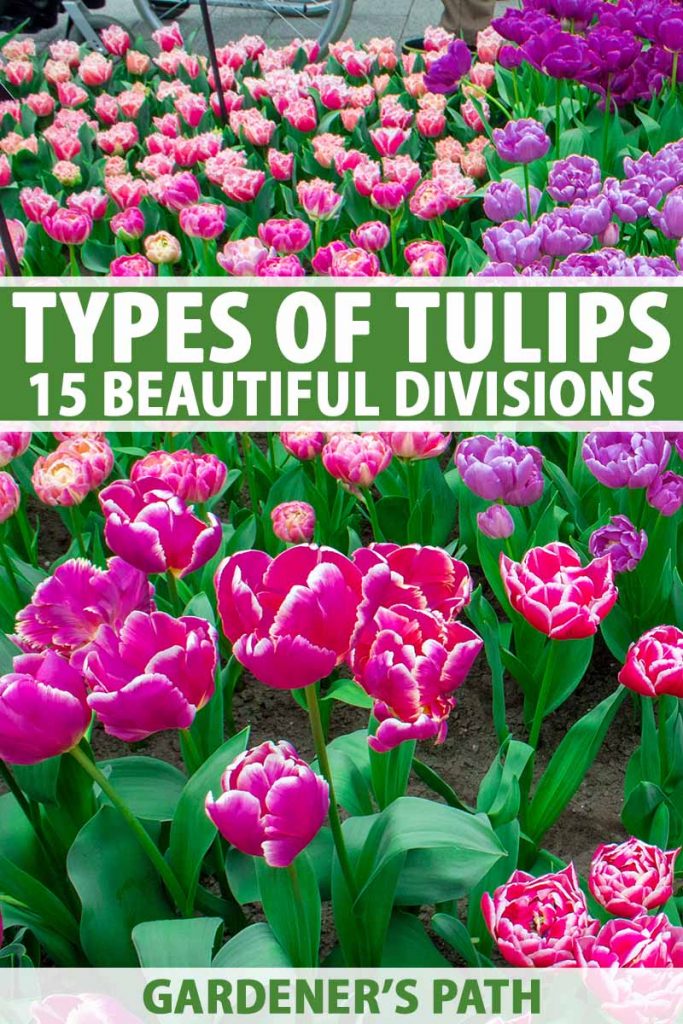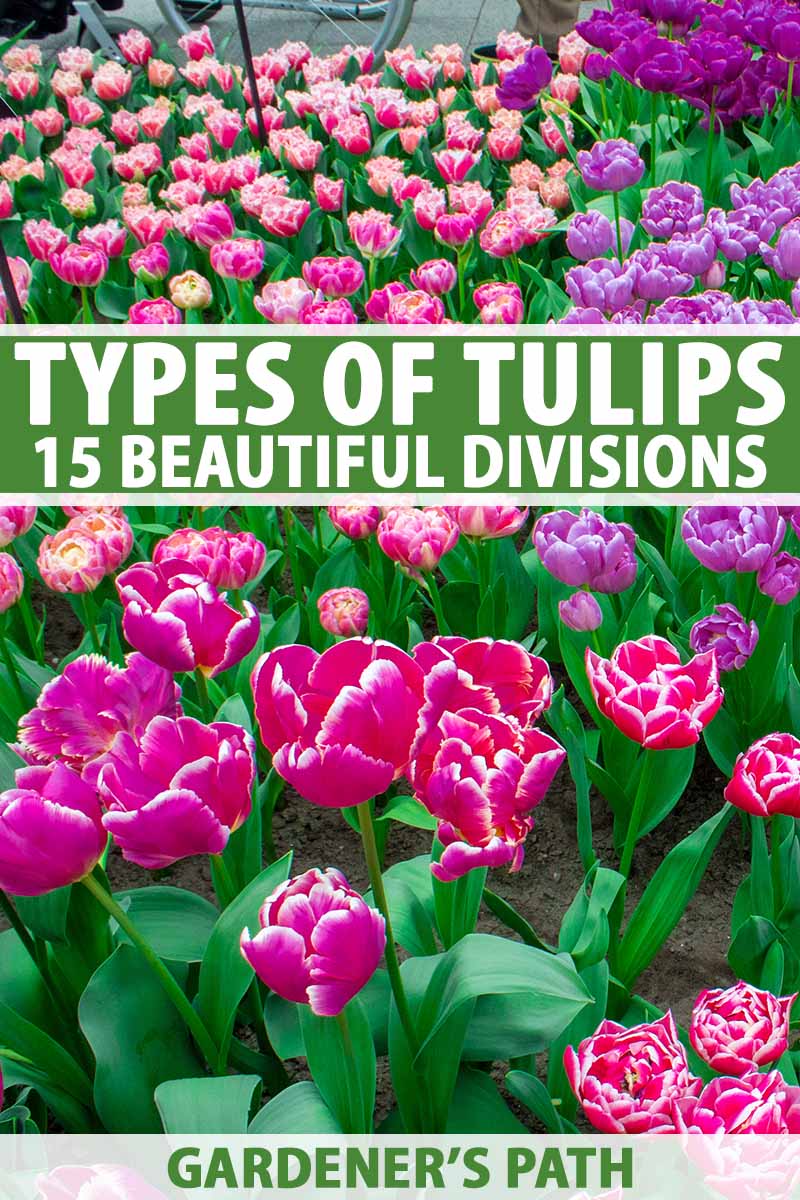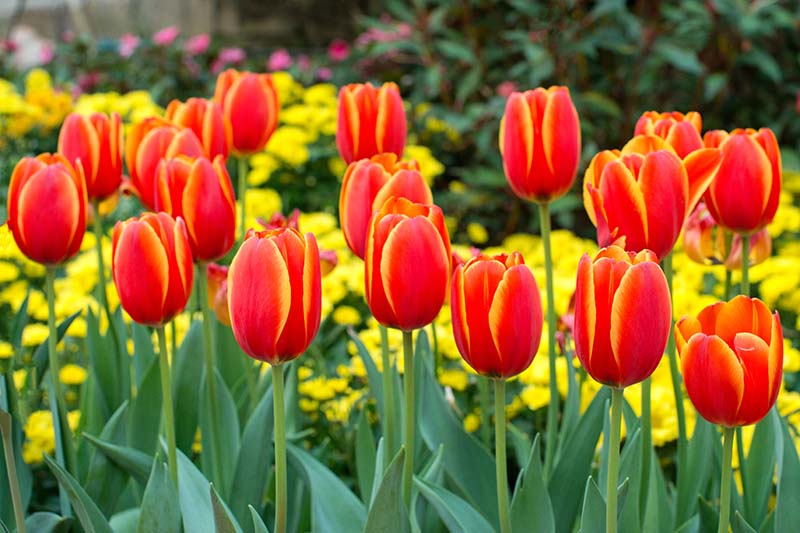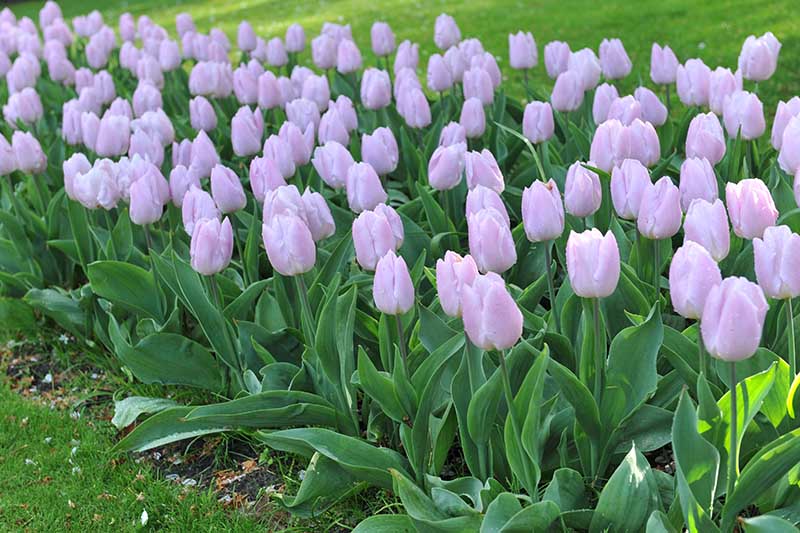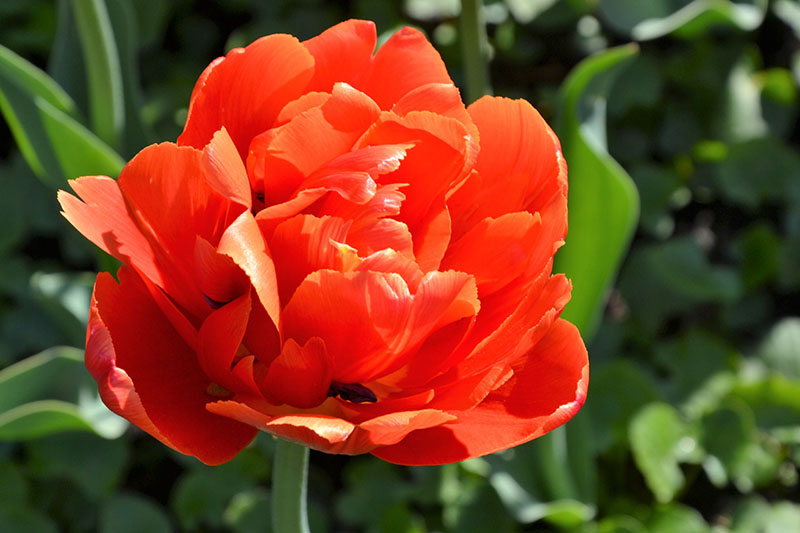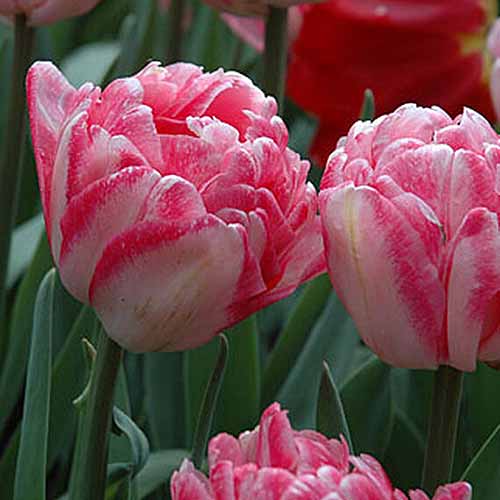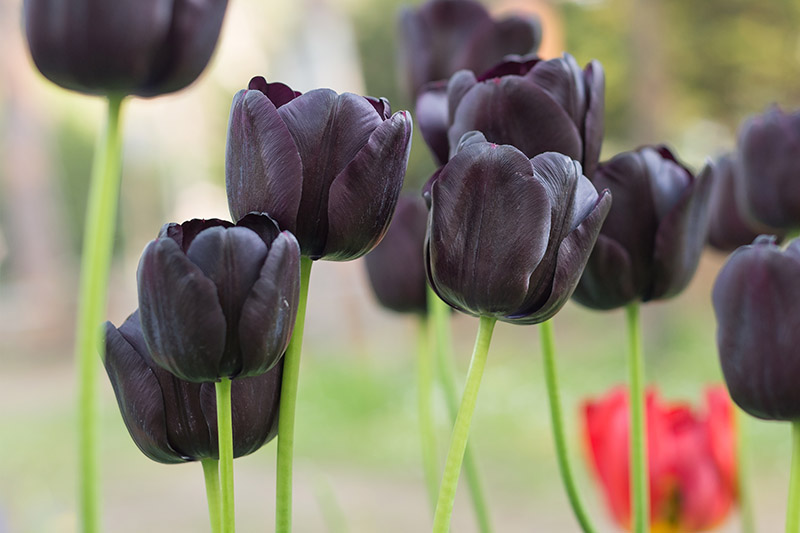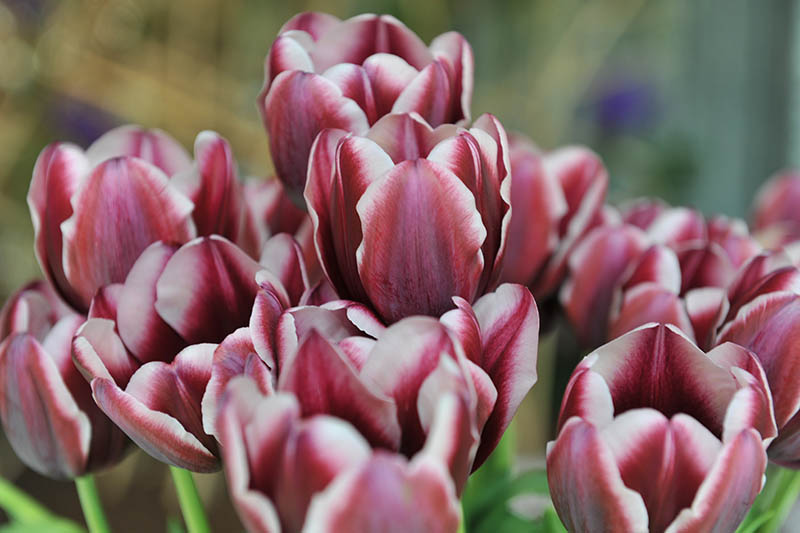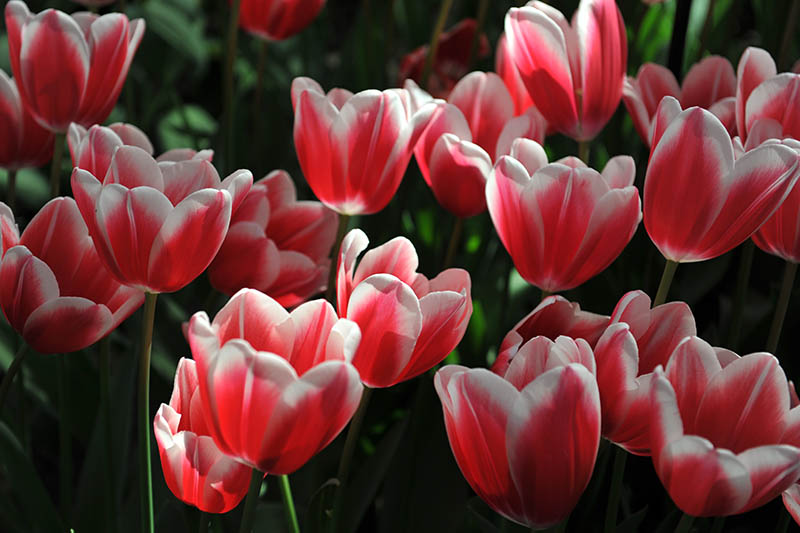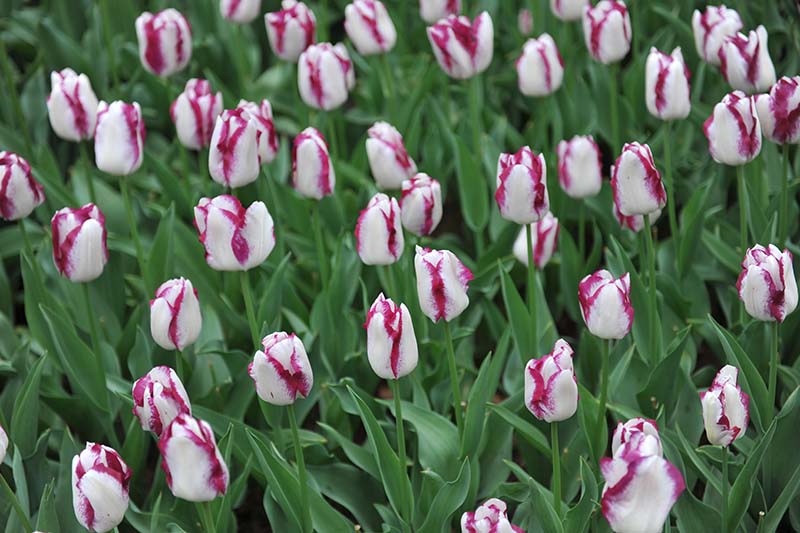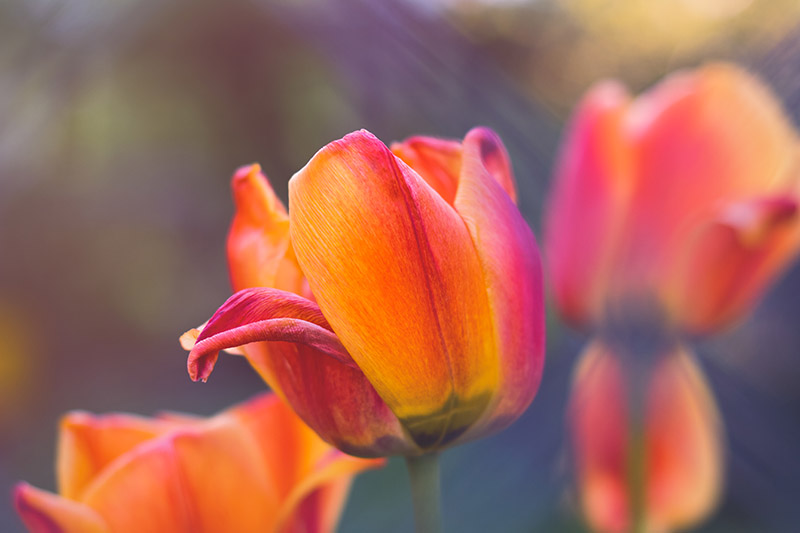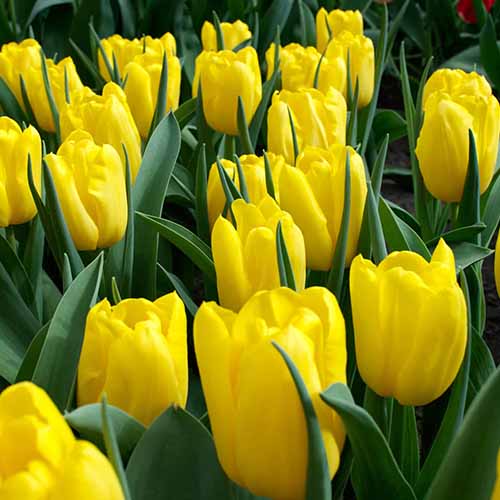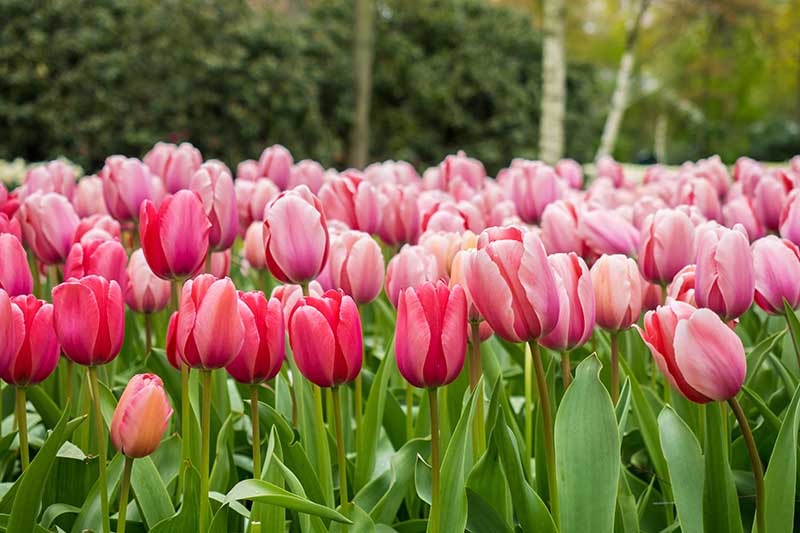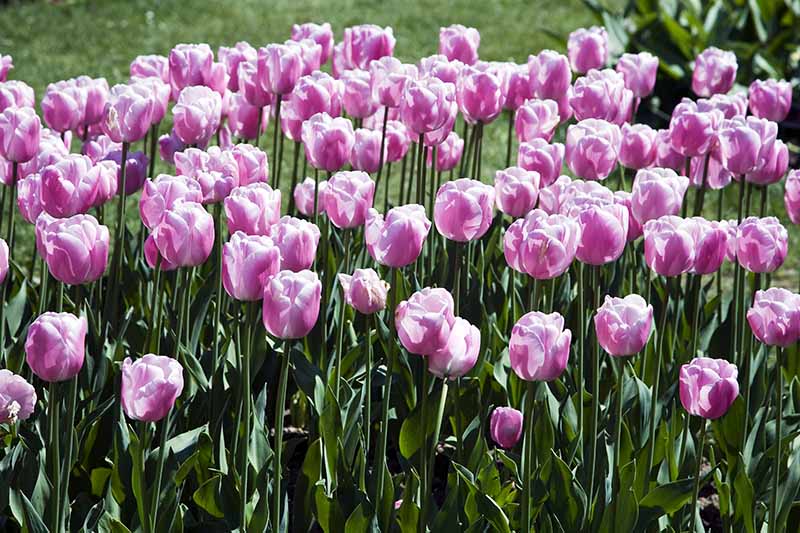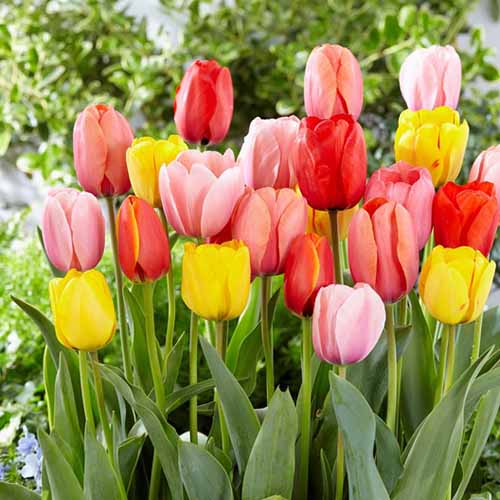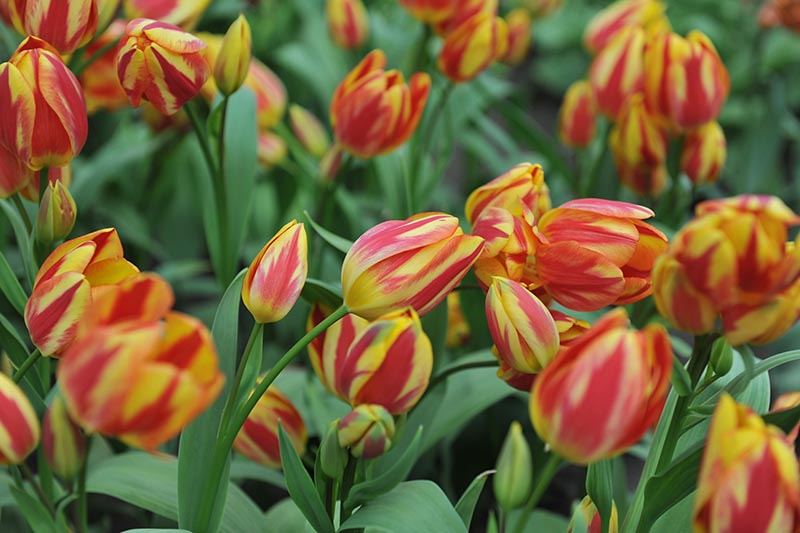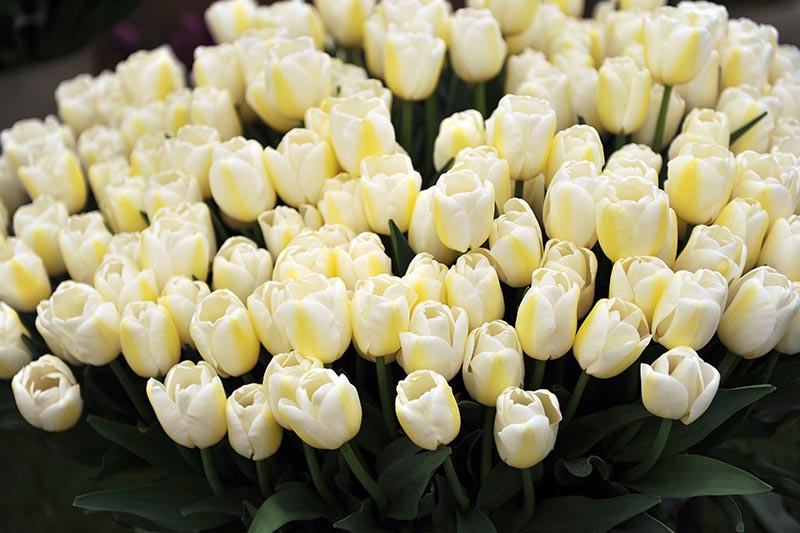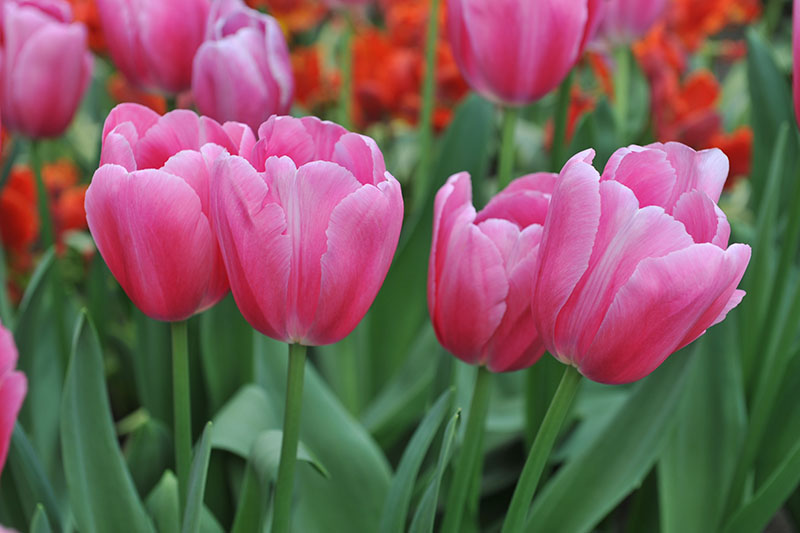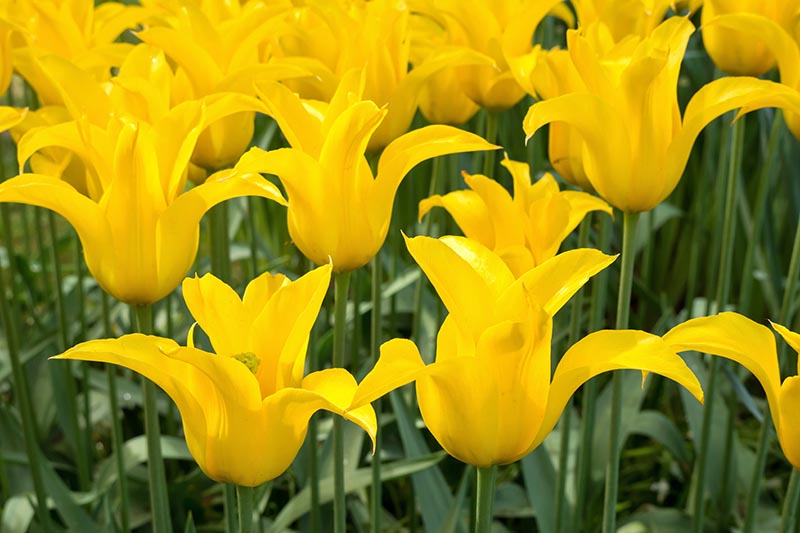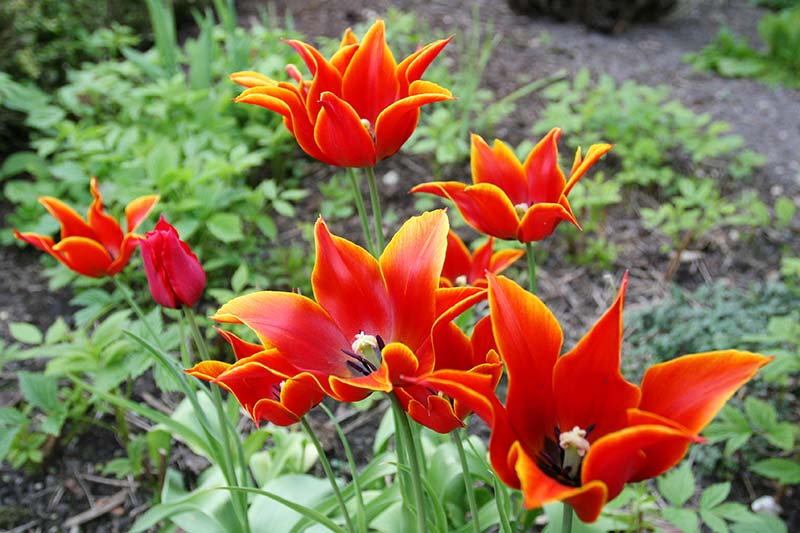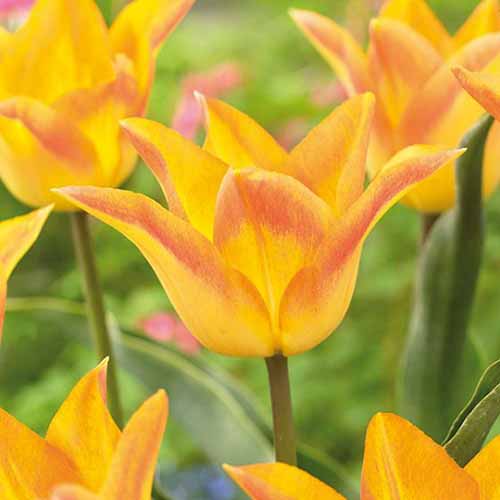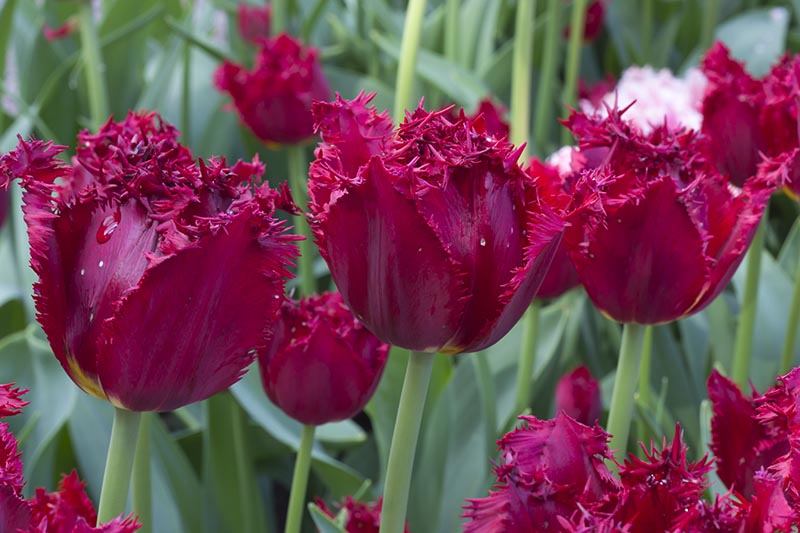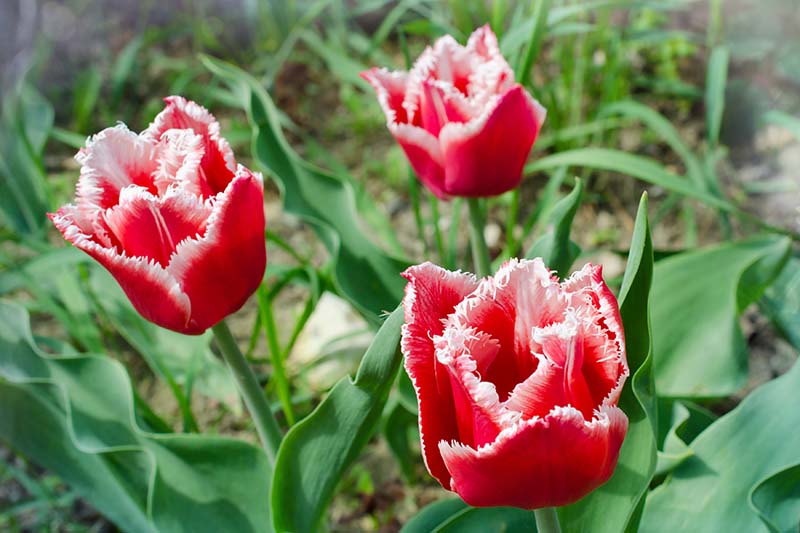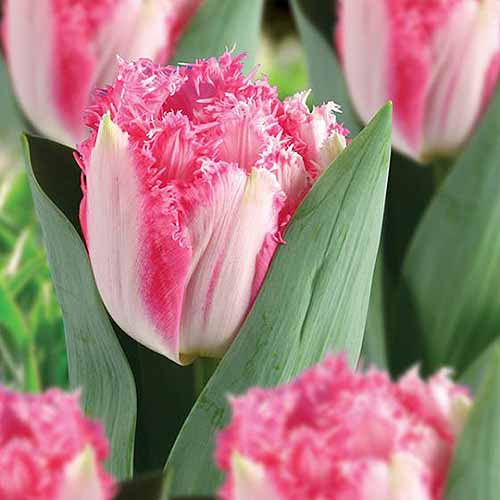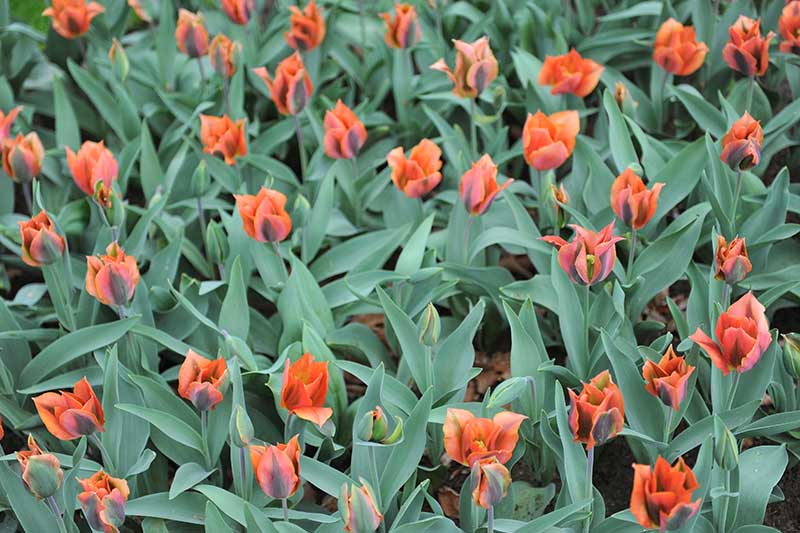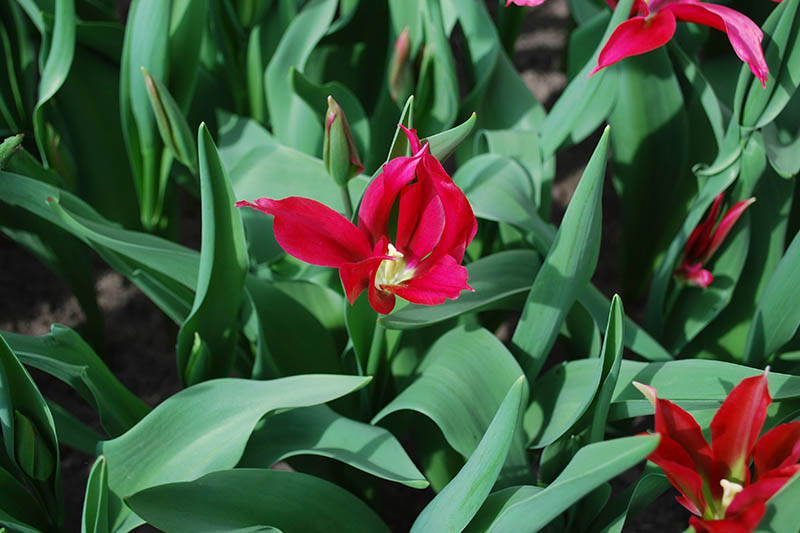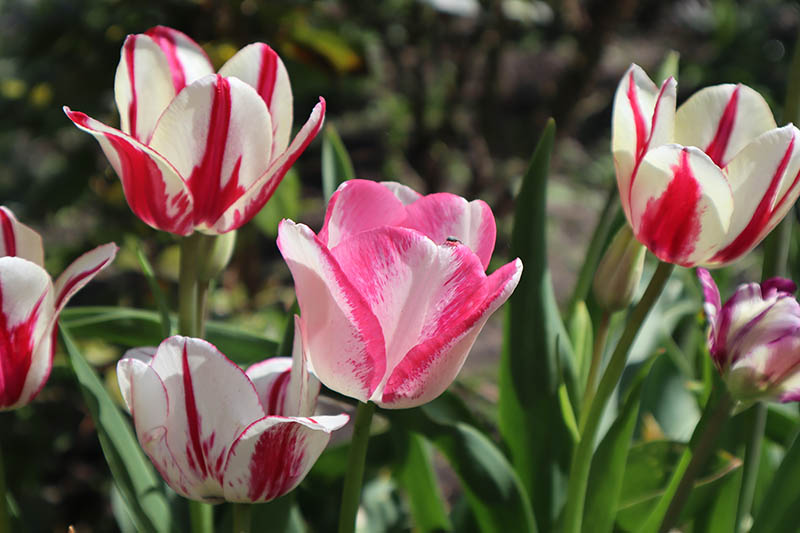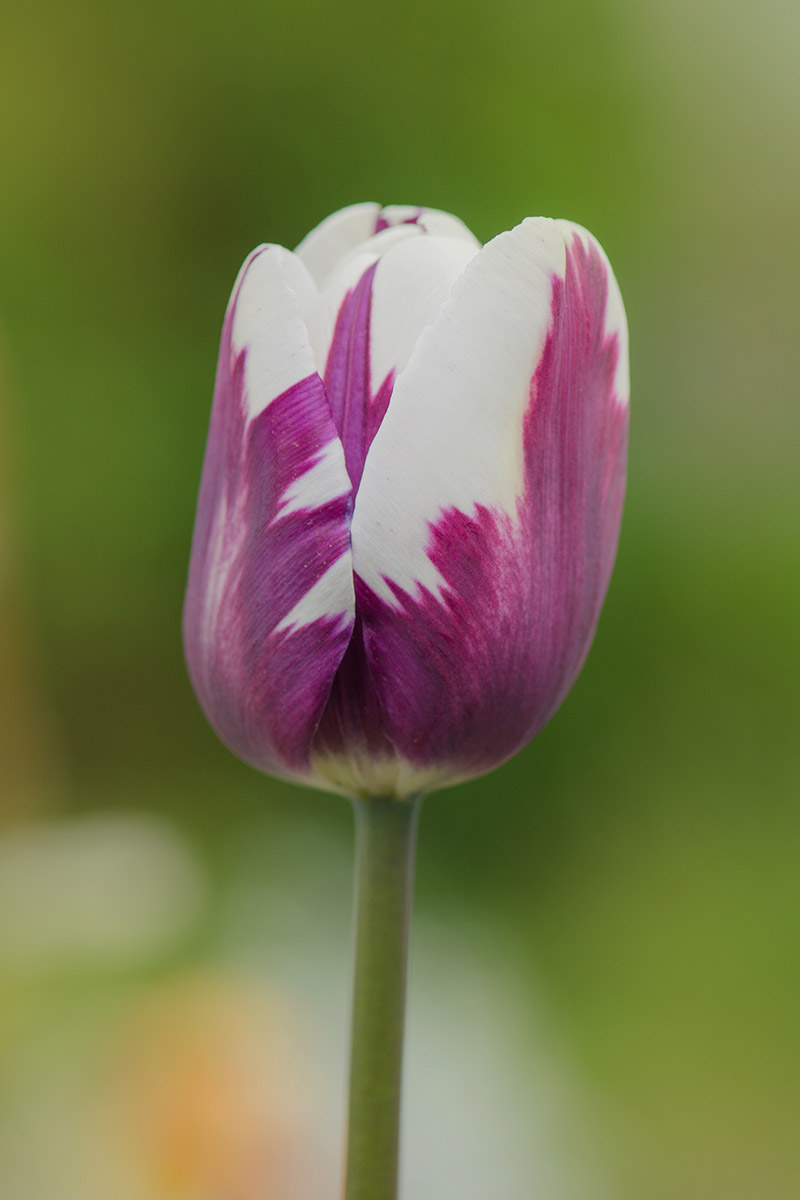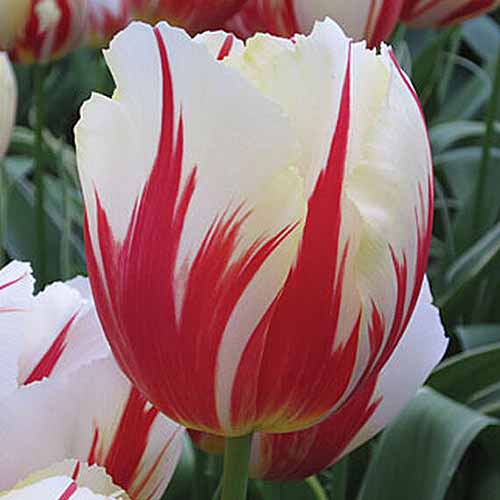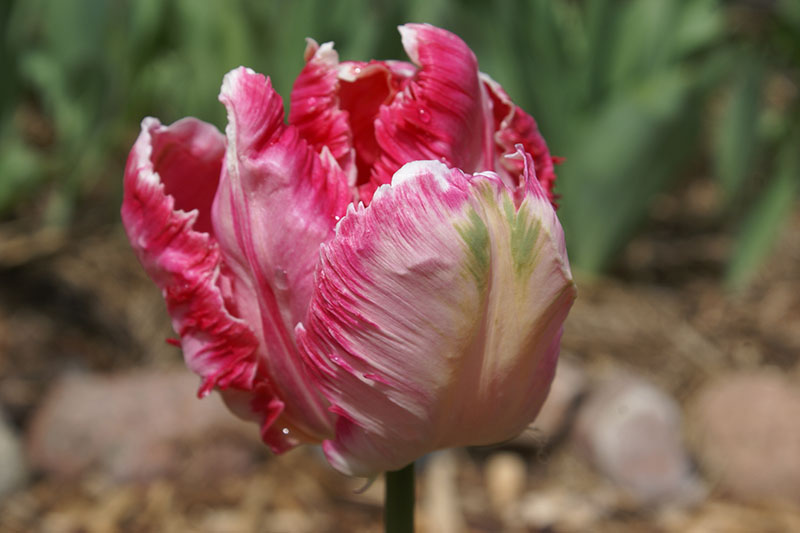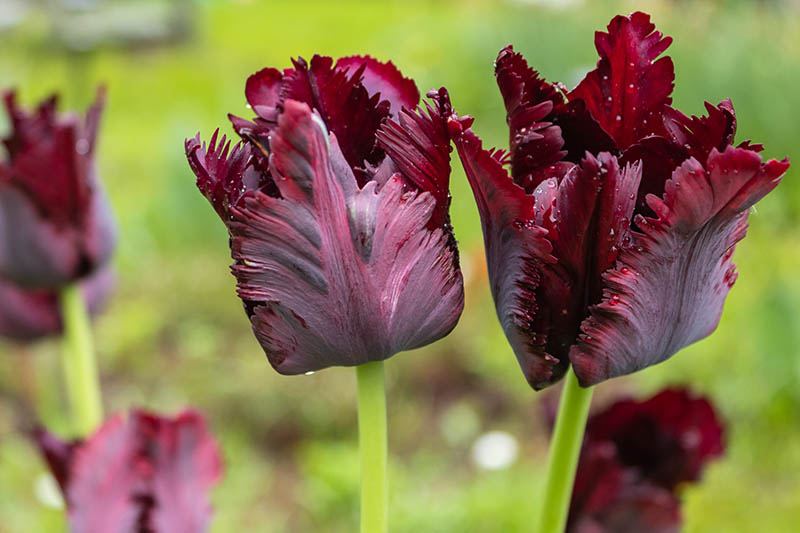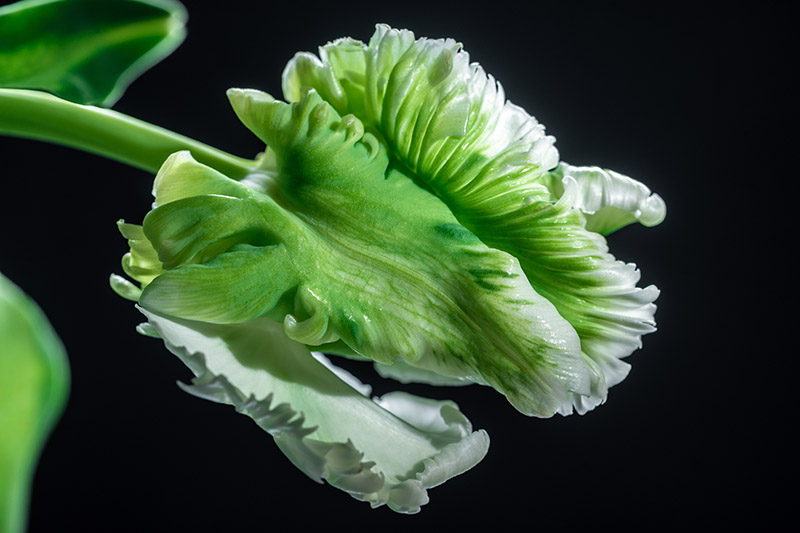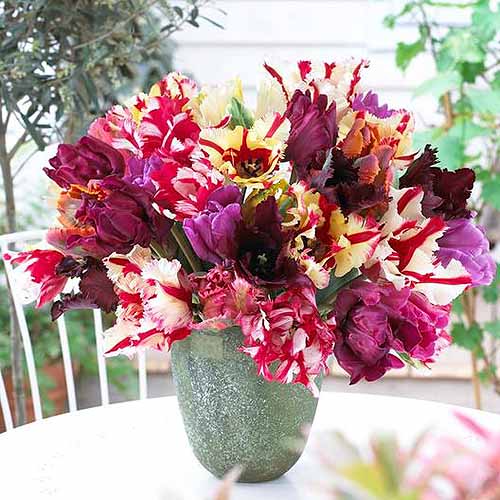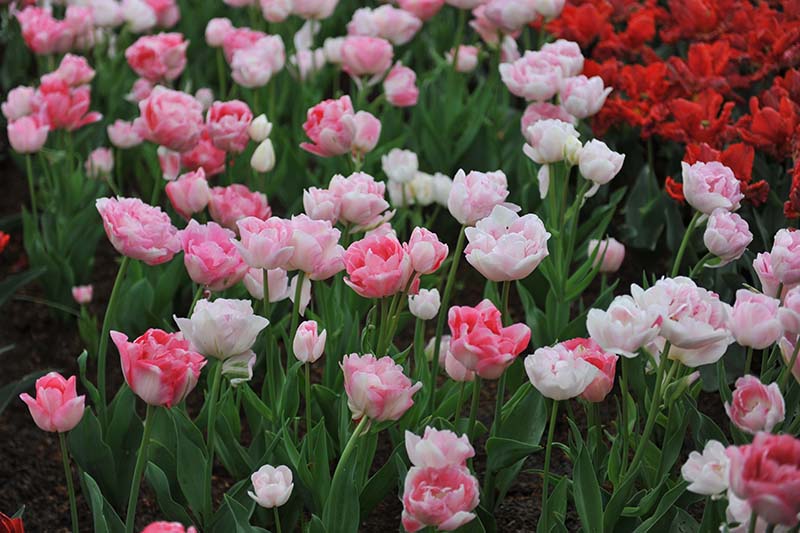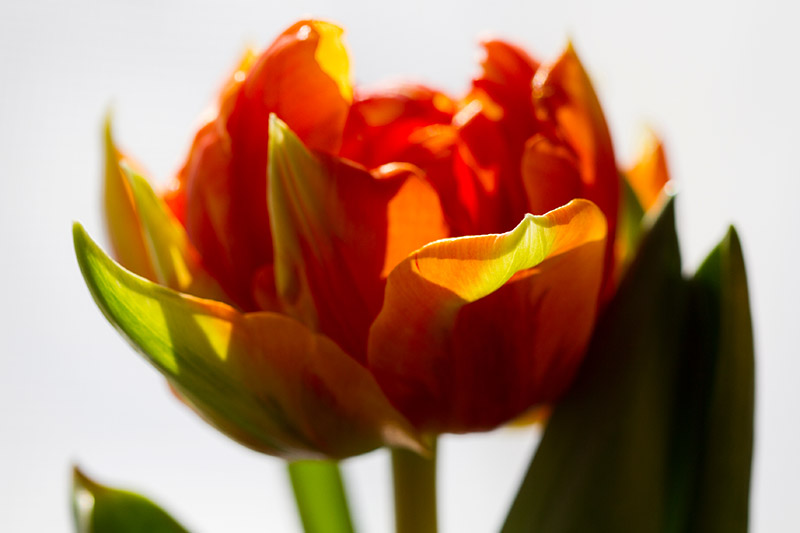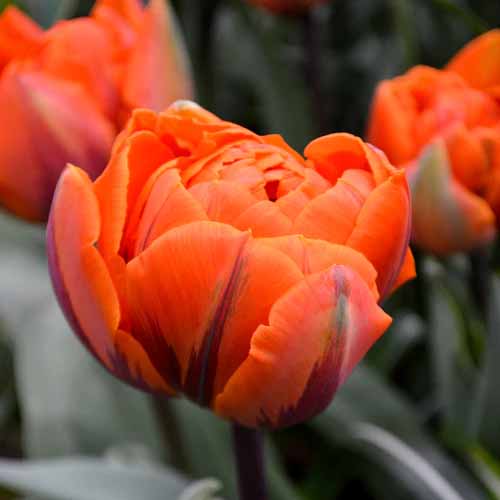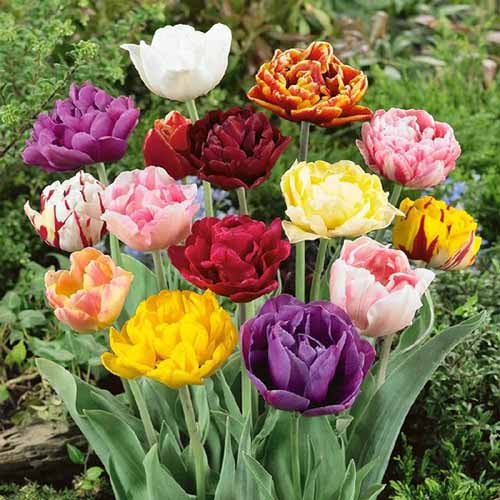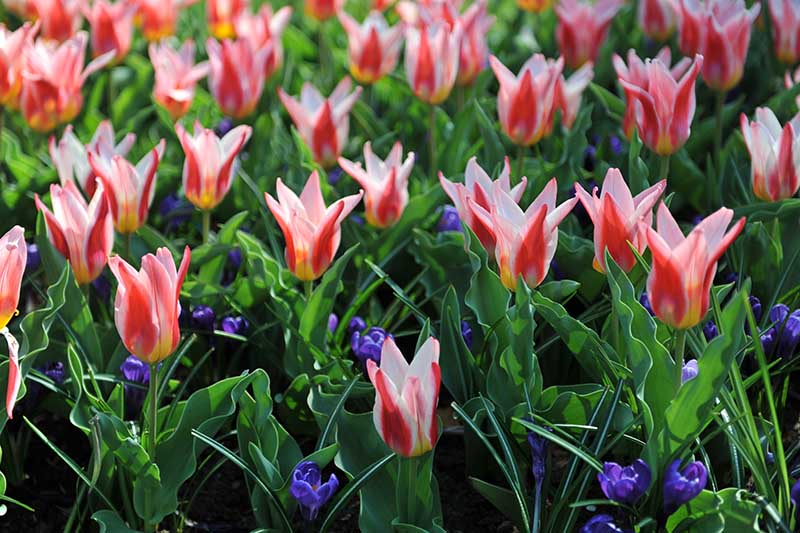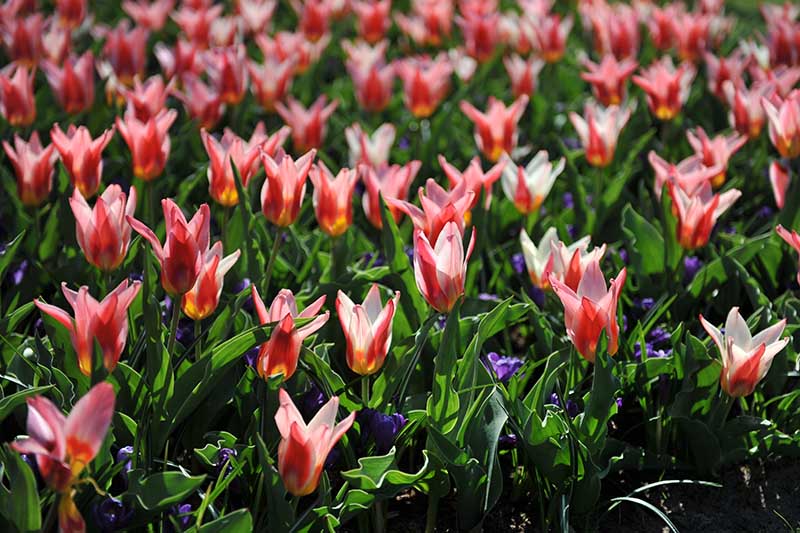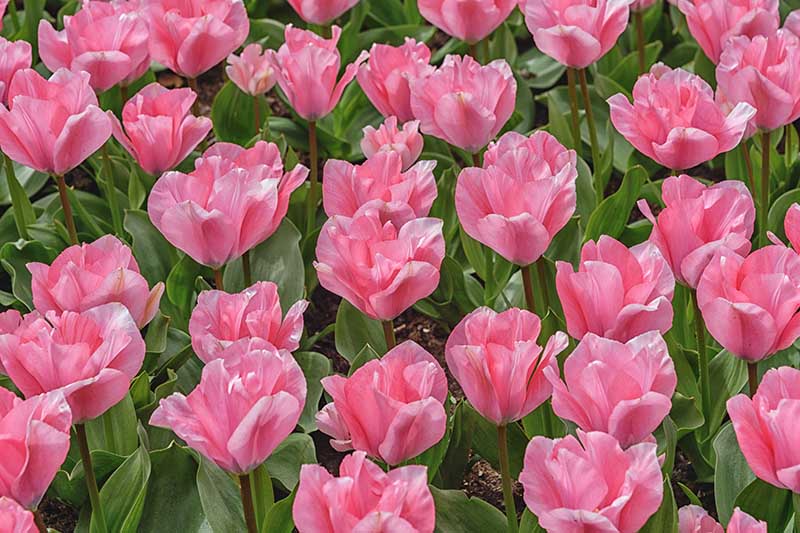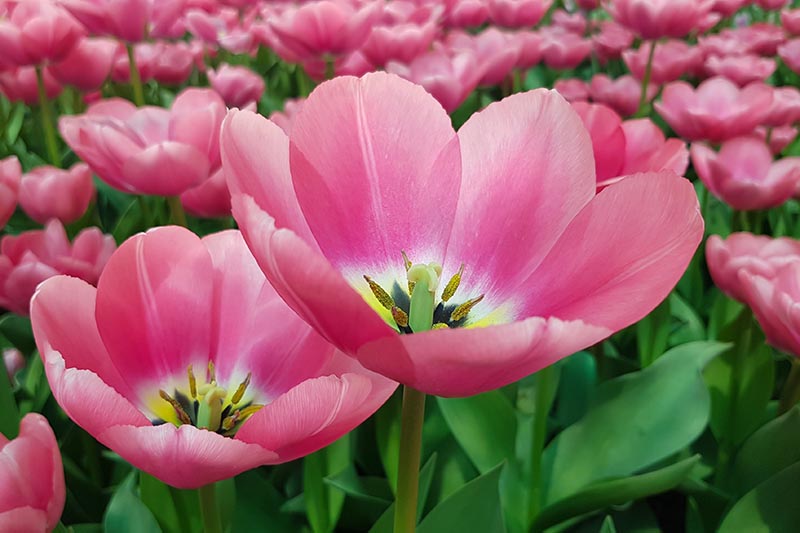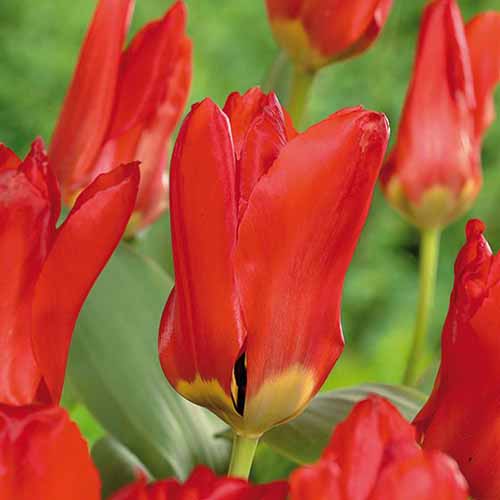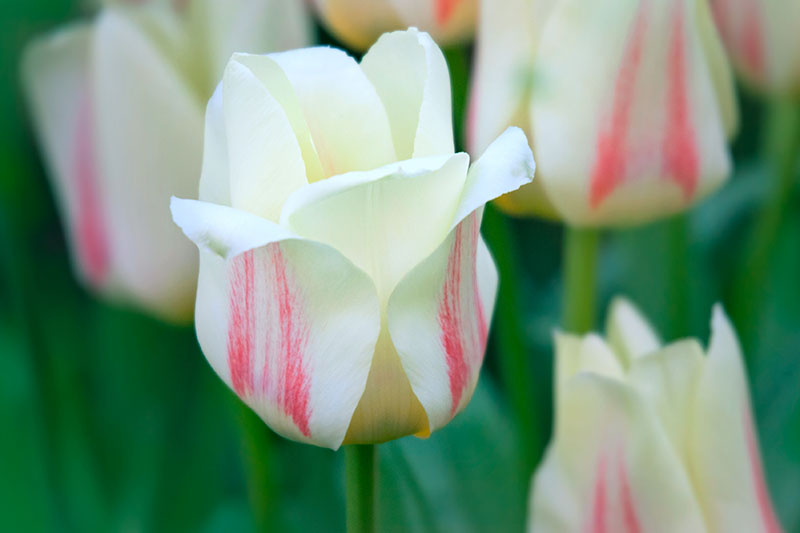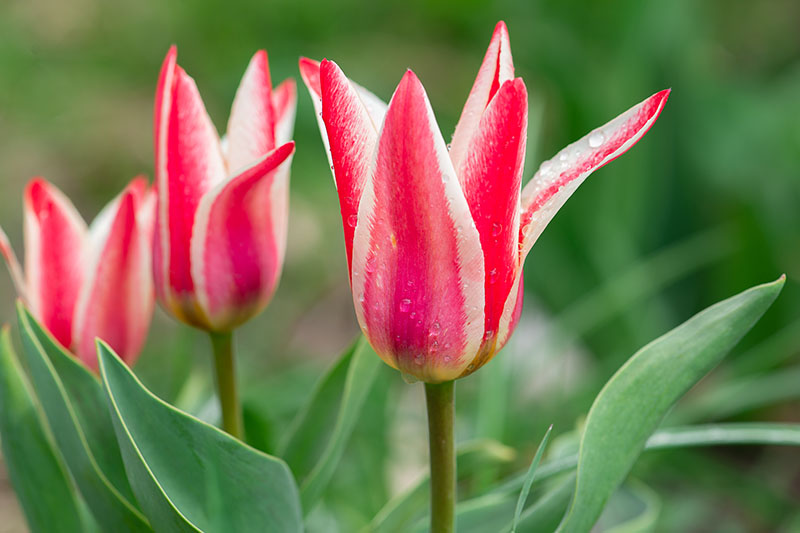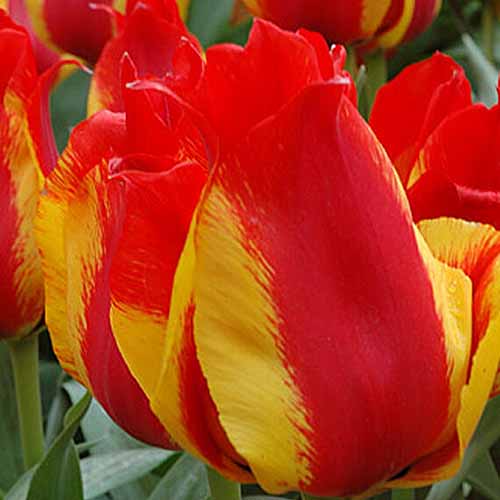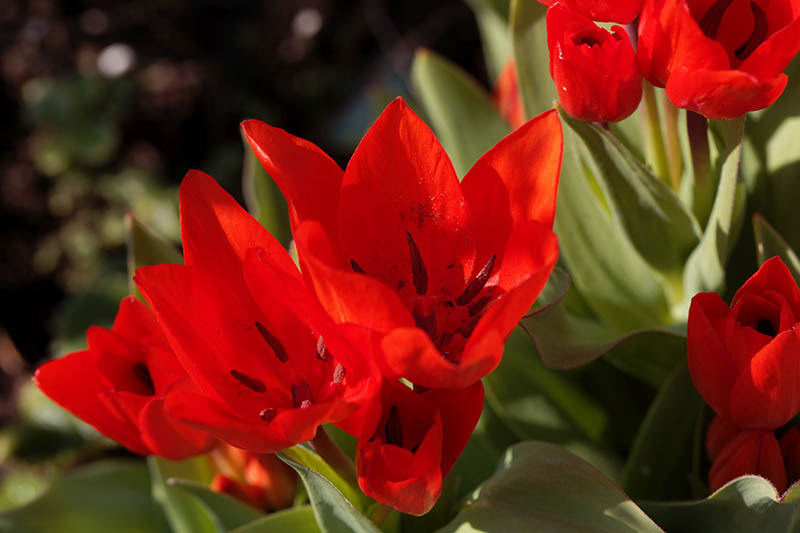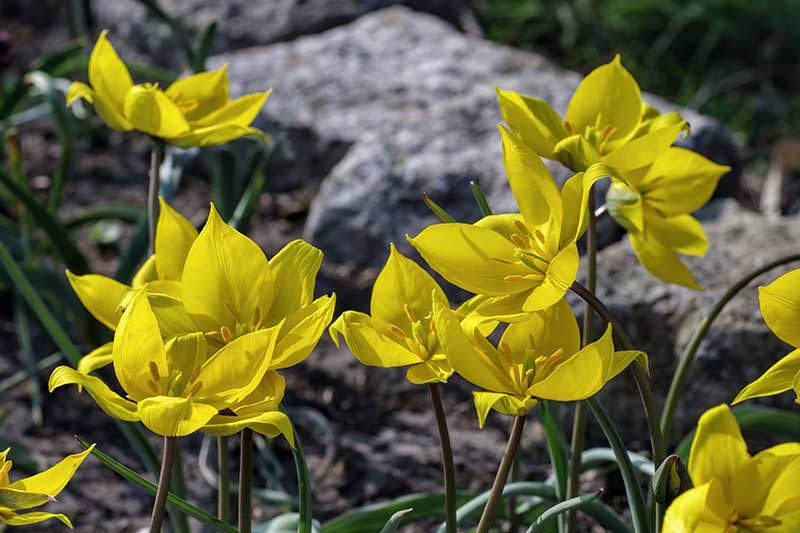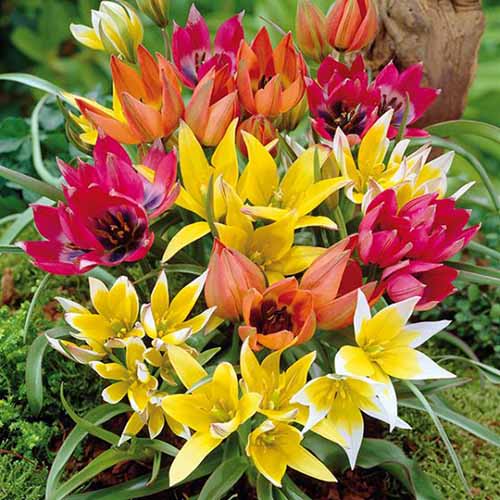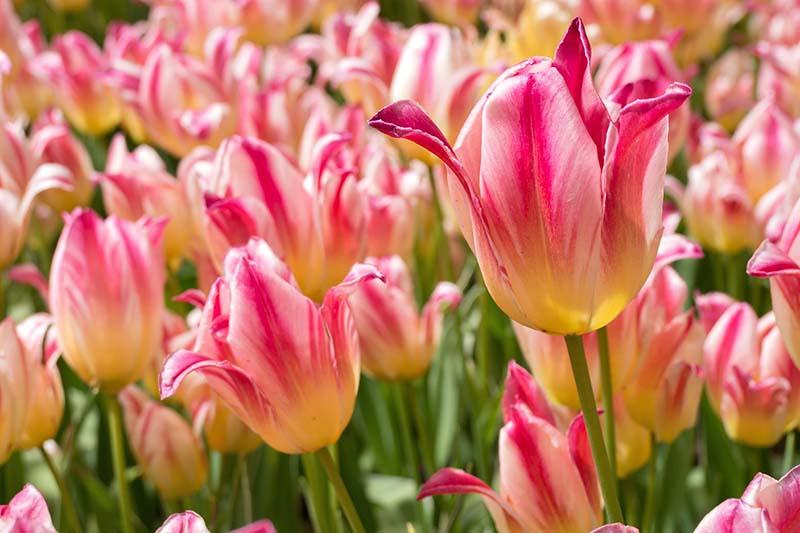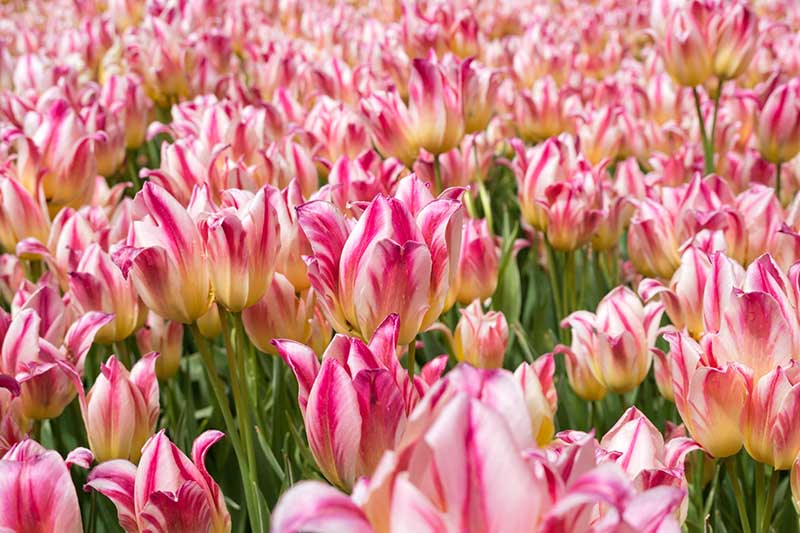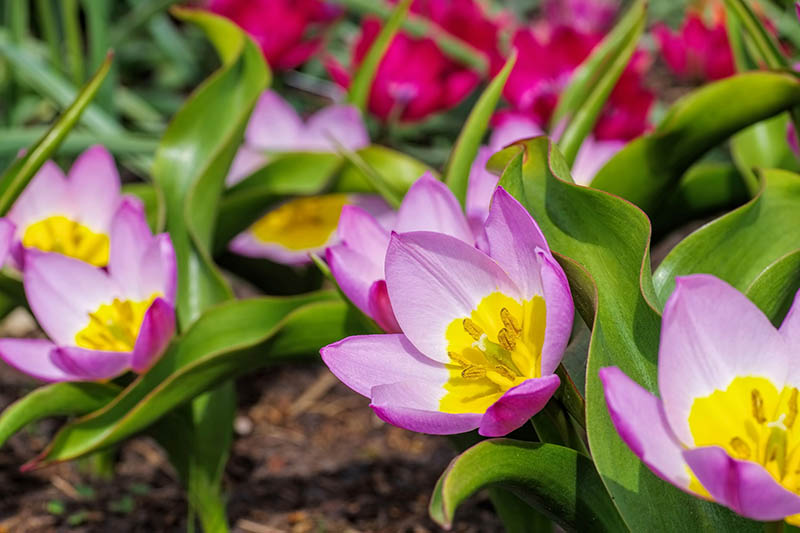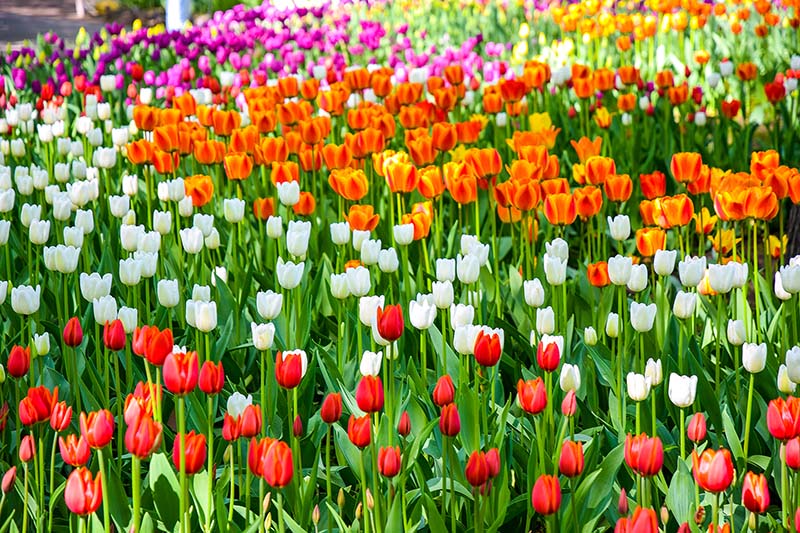If you’re a tulip-lover who’s ready to expand your knowledge about the specifics of the many different species and cultivars out there, or you’re simply looking for a few new types to add to your springtime flower beds this fall, this is the guide for you! To begin, tulips are classified in 15 different groups, or divisions. Each of these divisions has a number, and a name. These aren’t like college sports divisions, so the numerical order here is irrelevant – we’re not talking about comparing the most competitive and award-winning to the lowest quality and least decorated flowers or anything like that. We link to vendors to help you find relevant products. If you buy from one of our links, we may earn a commission. Instead, the name of each division is what’s important here. Tulips are categorized in these divisions based on common characteristics that they share, including similarities in blossom shape and origin. More like college clubs, you’ve got the French club over there, with their frou-frou feathered petals, and the art history geeks gathered in the courtyard with their striped blossoms. Or something like that. There are over 150 different species in the Tulipa genus, with over 3,000 different varieties registered to date, and more to come as plant breeders continue creating new hybrids. That’s a lot of tulips to sort through! How will you ever make your selections? Well, though there are occasionally some outliers, most divisions have an average height range that’s common among all the members. Some also have an average expected bloom time – in early or late spring. But there are types that bloom in mid-spring as well, of course, and divisions that have plenty of other things in common except for when they deign to show their true colors. Petal colors, that is. You’ll find miniature types that are perfect for rock gardens or borders, as well as towering tall ones, many with sturdy stems that are excellent for use in cut arrangements. Some are better suited to naturalizing than others, for a more wild, scattered look that spreads throughout your landscape with repeat bursts of blooms year after year. Some feature a sweet and alluring aroma, while others aren’t known for their scent. And how about bloom shape and appearance? That’s key to division membership! Most of the time. Some types have petals that open wide in the sunshine while others have fringed eyelash edges, or gnarled petals that twist and turn. Cups, bowls, stars, or elongated single blossoms, full double blooms with an abundance of petals, ones that resemble tulips, lilies, peonies, or water lilies, and even varieties that look just like the ones from the 17th century in the Netherlands, when Tulip Mania reigned, are available today. As it turns out, this visually appealing deformity was also the result of a virus, but I’ll go into that in a little more detail in the Division 9 section below. Many types of tulips produce a single stem and flower per bulb, while those in some divisions are multi-flowered, with multiple buds developing on branching stems. You can find just about every shade that you could desire – except blue – across these divisions, in single, bicolor, and even tricolor varieties. I’ll admit that before I wrote this article, I was nowhere near being able to make the claim that I was an expert on tulips. I remember fondly the red and yellow bicolor tulips of one of the gardens where I played as a child, and a few lipstick red ones with mysteriously alluring black interiors. I don’t know which cultivars these were, but I’m sure my heart will beat a little faster when I find them. Learning about the 15 (or 16, depending on who you ask – more on that later) different divisions that these beautiful flowers are grouped into, I gained a greater appreciation for the incredible amount of diversity that plant breeders have managed to coax out of the amazing members of this genus over the years. There’s really something for everyone. Well, unless blue flowers are more your thing. If that’s the case, let me point you in the direction of bachelor’s buttons, azure monkshood, and our favorite blue wildflowers instead. Sorry to disappoint! Instead of featuring blue shades in their own petals, I think they look lovely contrasted against the beautiful blue of the sky on a sparkling spring day, no matter the color. Though I haven’t figured out a way to grow tulips successfully outdoors since I moved to the hot and dry climate of southern California, a potted plant would be a welcome addition to brighten up my living room in the springtime. I encourage others growing in zones not suited to bulbs to give this a try as well if you’re really in love with these flowers, instead of missing out. Sure, you probably won’t be able to grow them as perennials, but take heart – I didn’t realize myself until I dug into the research that many types of tulips are not particularly long-lived, and you’re lucky if you get blooms in consecutive years for a good stretch of time. I think that makes them all the more special. Let’s dig into the divisions, shall we? Here’s what’s ahead: Let the games begin!
Division 1 – Single Early
Medium-sized single blooms are the key feature of tulips in this group, and as their name suggests, these are also some of the earliest to bloom, in late March to early April. If you’re looking for that classic tulip shape like we all learned (roughly) how to draw in elementary school, this is your guy. Heights range from six to 16 inches (25 to 60 centimeters) so this is considered a short variety, and blooms are often pleasantly fragrant. Add these to rockeries or the fronts of flower beds where they won’t be overshadowed by taller springtime plants, or choose Single Earlies for wintertime forcing indoors. With heights ranging from 12 to 16 inches (25 to 40 centimeters), most are closer to the foot-high end of the scale, qualifying as short varieties. Single Early Mix Single Early Mix blooms in a variety of colors to surprise you in spring. You can find bags of 10 to 100 bulbs available at Eden Brothers.
Division 2 – Double Early
Semi- to fully double blooms with an abundance of petals for fullness are the key feature of tulips in this division, and these bloom (say it with me…) early! Typically, you’ll see buds start to open in early to mid-April. Blossoms can measure up to four inches in diameter and their stems are strong, so you won’t have to worry about wind protection. Over 200 different types are currently available from this group, though it’s important to note that the available color selection is more limited than what you’ll find in other divisions. Yellow, red, orange, white, light pink (helloooo, ‘Foxtrot’!), dark pink, don’t forget regular pink, dark red, purple, lilac, light yellow, yellow, cream, and bicolor varieties are available. Triumph is the goal, and this feeling epitomizes the unbeatable spirit of any good D-3 team, one that strives for perfection and struggles in regional competition against better funded teams, often at (ahem) less academic schools. ‘Foxtrot’ Find ‘Foxtrot’ bulbs available at Burpee.
Division 3 – Triumph
I hesitate to harp on the whole college sports analogy – and have I mentioned that I didn’t even play any team sports when I was in college? (Ha, who, me? Not any officially sanctioned ones, at least, though I would have loved to start a Beer Die league!) Nonetheless, I can’t help but bring it back around. I did volunteer my services briefly as manager of Swarthmore’s D-3 men’s rugby team (Go Evil Buzzards!) and though I basically had no idea what the rules of the game were to start, I always loved watching the matches, running up and down the sidelines at tournaments to throw the flag down to mark where the ball went out, and filling up red Solo cups from the keg afterwards. How does this relate back to tulips? Other than the fact that I attended school in an arboretum (no tulips in sight that I can remember, but there were plenty of roses, hydrangeas, stunning Japanese maples, a little triangle-shaped island of tufted ornamental grasses up near the Science Center that I called “my planet,” and one of my favorite plants of all time – a gorgeous purple smoke bush that lived outside the western end of the main building on campus – among countless other carefully-tended and unique specimens), maybe… it doesn’t? I kid, I kid! Triumph is Division 3. And if you ask me, this particular grouping just might be the best of the bunch, in terms of sheer numbers as well as height and the available color options to choose from. That’s a winner. It’s striving. It’s gonna keep thriving. Sure, numerical rankings “don’t matter” here… but maybe we should start a petition to get Triumph bumped up the list to number one? Let’s return to the topic at hand – Triumphs are hybrids of single-blossomed early and later-blooming cultivars, midseason varieties that bloom in April, with average heights ranging from 15 to 20 inches (40 to 60 centimeters is the norm, sometimes stretching up to 70 centimeters tall), meaning they’re in the medium range. There are a couple shorties in the bunch, like the 30 to 40-centimeter ‘Madurodam,’ but hey – it’s a large group and it’s not like we’re picking favorites for a pickup basketball game here. (Thank goodness, because I am 5’3” and do not make up for this height deficiency in skill – though I have advocated for many years for “short league basketball,” something that comes up far too often for someone who can’t remember the last time she held a basketball, unless clutching that controller until my thumbs develop blisters while playing NBA 2K counts.) Triumph blossoms are cup shaped, stems are strong, and there are nearly 1,400 registered varieties in this group for you to choose from, with cultivar names ranging from A to Z! If Triumph is your shining glory in terms of tulip divisions, maybe it will be less disappointing than it might be otherwise for you to find out that most of these varieties are considered “short-term perennials” that only bloom for a few years – after all, you can clear out the aged bulbs and replace them with a new cultivar, say, three or four times each decade! If you have enough space, maybe you would work through all of these in a lifetime… You can try, at least. Please let me know if you do. Colors include purple, red, cream, yellow, salmon, pink, white, violet, lilac, orange, brown (look for ‘Zeelandia’ if chocolate-hued flowers are your jam), maroon, dark purple, dark red, and even black, with single-hued and bicolor options. And oh, those bicolor options. There are of course too many to list here, I’m afraid, but let’s hit a few of the highlights: The red and violet ‘Attila’s Elita’ is sure to make a regal addition to the garden, maroon and cream ‘Nashville’ is sweetly sophisticated, and don’t miss ‘Alex Torres,’ a red and orange combo. If you’ve always dreamed of getting married in the fall but your mother-in-law insists on springtime, maybe you can reach a stylistic compromise with a bouquet of brown and orange bicolor ‘Cairo’ tulips. I’m more partial to the red and violet mashup myself – or perhaps the stunningly unexpected ‘Blackout’ – bet you can guess what color that one is. It reminds me of a few nights ago here in Los Angeles, during the latest heatwave when we lost power for a few hours. Typically ranging in height from 45 to 70 centimeters tall (17 to 30 inches), flowers in this division are midseason bloomers that make an appearance in May. Perhaps the bright, buttercup yellow hues of ‘Strong Gold’ are more appealing? ‘Strong Gold’ Go for gold and snag a packet of 25, 100, 500, or 1,000(!) bulbs at Dutch Grown.
Division 4 – Darwin Hybrid
Named for the famed naturalist himself, these are for the most part hybrids of single late and species tulips, though some are multi-headed. Large flowers grow on strong stems. These are some of the best picks if you’re looking for perennials, and Darwins will often return for at least a few years in a row. Well, okay, there are a few outliers who might not make the team. But we’re not really talking about basketball here, and there’s nothing wrong with a 30 to 40-centimeter-tall tulip, now is there? Darwin Hybrid Mix You can find a delightful mix of Darwin Hybrid bulbs available at Eden Brothers.
Division 5 – Single Late
Reaching average heights of 24 to 30 inches (40 to 80 centimeters), this is most definitely a potentially basketball-playing tall group, featuring some of the tallest cultivars. I didn’t think so. With over 450 different varieties of large, egg-shaped flowers to choose from, these might be a little late for Easter but they’re sure to make a gorgeous addition to your garden. Sometimes called “Cottage” tulips, Single Late blooms appear in May, just in time for that Senioritis to kick in. Long-lasting and heat tolerant (as they would have to be in May!), a wide range of color options is available, including violet, white, pink, yellow, white, purple, red, orange, lilac, black, cream, and bicolor combinations of these. Single long and narrow flowers are cinched in tight at the waist, with little pointy petals that flare out around the rim. Ooh la la, these are great. I implore you – do not miss the violet, white, and yellow ‘Atlantis.’ This tulip may not literally be able to transport you to a mythical island dreamland, but short of someday being able to plop a true-blue tulip in the soil, this cultivar is (does that fingertips to lips mwah kiss thing) so choice. Single Late Mix You can find a Single Late Mix, providing a variety of bold colors, available at Eden Brothers.
Division 6 – Lily-Flowered
Okay, so imagine what a lily looks like. You got it? Now imagine that in tulip form, and you’ve got the Lily-Flowered division. No, they’re not some kind of hybrid cross with daylilies, they just look a bit like them. Averaging about 18 to 24 inches tall (50 to 65 centimeters) with some shorter varieties that may stop lengthening in the vertical direction around 12 inches, and a few tall guys that may Stretch Armstrong it up and go for 30 inches, these late bloomers bust open their buds in May and they’re excellent for cut arrangements. With about 130 different options to choose from, white, cream, pink, red, orange, yellow, lilac, violet, and purple varieties are available, and some bicolor cultivars even have petals that are edged or feathered in contrasting colors. I’m personally more of the celebratory-gardening-white-nude persuasion (maybe once a year, and in my dreams – college is over after all, and I mostly masquerade as an upstanding citizen during the daylight hours these days). For something in more of a sunset range, ‘Moonblush’ glows in orange with red accents, and changes shape as it blooms. This bicolored cultivar is sometimes called a “chameleon” tulip as it changes from bright yellow to a deep blood-red over time. ‘Moonblush’ You can find a pack of 10 bulbs available at Nature Hills Nursery.
Division 7 – Fringed
If you’re one of those people who has always longed to throw on a leather jacket with all the fringe or a pair of fluttering falsies before heading out to the garden, this one’s for you. You’ll match your flowers perfectly. But oh, that fringe! The whiskered top edge of these beautiful petals often exhibits a contrasting color or paler shade than the remainder of the tepals, and the single blooms grow on stems that can range from 20 inches (40 to 80 centimeters) in height, depending on the cultivar. Of course, then there’s ‘Pincode,’ a much shorter specimen than most in this division, at 25 to 35 centimeters tall. With over 150 different varieties available in this division of mid- to late bloomers, flower colors include red, yellow, cream, pink, red, purple, white, dark pink, violet, orange, and lilac. And yeah, I’m at it again. I just can’t resist these tricolor tulips! If you need another one to add to your garden dream journal, don’t forget ‘Agape,’ a purple, red, and white beauty that will surely have you letting the flies in while you drool with pleasure, or perhaps leading to your eventual conversion to join the believers at the Agape church, er, “International Spiritual Center.” Imagine with me a selection of at least 50 different registered varieties, all exhibiting varying amounts of green in their blossoms, in beautiful streaks and splotches. I’ve read that many of the cultivars in this category are mutants of Single Lates. How interesting. They are also sometimes referred to as Crispas. ‘Crispion Love’ has delicate deep pink fading to soft pink fringed petals, adding a romantic touch to your garden. ‘Crispion Love’ You can find packets of 10 bulbs available at Nature Hills Nursery.
Division 8 – Viridiflora
I know the blue flower lovers are still weeping in the corner, but green flower lovers, hear me now! Viridiflora is the division that will make all your dreams come true! So gorgeous, so unique. These generally reach somewhere around 18 inches tall (23 to 60 centimeters), and most bloom in mid- to late spring. Long-lasting as cut flowers, they’ll look stunning in bouquets and arrangements, and in your flower beds as well. Combinations of green plus pink, salmon, white, red, yellow, lilac (check out ‘Doll’s Minuet’), and orange are available, as well as tricolors. I recommend the green, pinkish-red, and white ‘Green Village’ if the village you’re repping is somewhere in oh, say, Italy, or maybe Mexico. Haven’t heard of this particular period in history, when some bulbs sold for more than houses? Read our full guide to growing tulips to get the scoop. I heard Rafa’s started his own garden this year, so maybe I can convince him to add some of these to the pots on the patio. More of the painterly type? ‘Artist’ glows with pale pink surrounding delicate green accents, with a watercolor look so realistic, visitors to your garden will swear they can actually see the brushstrokes. ‘Artist’ You can find packets of 10 ‘Artist’ bulbs available at Burpee.
Division 9 – Rembrandt
Named for the famous Dutch painter, these resemble the iconic tulips that were often featured in 17th century paintings from that part of the world, at the peak of Tulip Mania. With excitingly unusual striped patterns, these “broken” blooms were once made more beautiful in the eye of many a beholder as the result of a virus. Sadly, today you won’t be able to find an exact match for those tulips of old that you’ve seen featured in museums (sorry!) but some modern-day cultivars are available. And these are virus-free, so you won’t have to worry about the other tulips in the neighborhood if you plant these. I’ve seen the petals on these described as ruffled, feathered, curled, twisted, puckered, and fringed. With bright red swirls through creamy-white petals, ‘Carnavale de Rio’ is a beautiful example of a Rembrandt. ‘Carnavale de Rio’ You can find bulbs for ‘Carnavale de Rio’ available at Burpee. Ranging in height from 18 to 24 inches (45 to 60 centimeters), bloom times vary.
Division 10 – Parrot
Bird lovers, rejoice! Your favorite talkative and colorful avian friend has a floral counterpart known as the Parrot tulip. However you want to describe them, these tulips are vibrantly hued and downright birdlike if you squint just right, but you don’t have to worry about them flying away if you want to give them a pat when no one is looking. Will you be able to teach them to talk? I don’t know that anyone has attempted this yet, but attempting to engage your tulips in conversation is most definitely encouraged. And, just like a pet, they’ll need a little extra protection. Plant these in a location where they won’t be exposed to harsh weather conditions. These late bloomers make excellent cut flowers, and they range in height from 14 to 22 inches (40 to 65 centimeters). Nearly 120 different single-blossomed varieties are available in this division, and you can read more about them here. Particularly long-lasting in the garden or as cut flowers, many varieties are fragrant, adding to their appeal. Can’t decide? Why not try a mix of a variety of colors, all with the classic Parrot shape. Parrot Mix You can find Parrot Mix in bags of 10 to 100 bulbs available at Eden Brothers.
Division 11 – Double Late
Also referred to as Peony or Double Hybrid tulips, these exhibit peony-like double blossoms that are flush with petals. Plus, since ants don’t “help” to open these, hopefully you won’t have to worry about de-bugging your precious cuttings before you arrange them in a vase. Most of the nearly 200 registered varieties grow 15 to 22 inches in height (30 to 60 centimeters) and flower late in the season, with large flowers on long stems. Be sure to plant these in a protected location, since they can suffer damage in heavy rain or strong winds. Early bloomers, the flowers have a tall, narrow cup and pointed petals. But the stems are short, and most plants max out at just six to 10 inches in height (10 to 25 centimeters). I’m particularly partial to the pink and green ‘Christo’ cultivar, the orange and purple ‘Orange Princess,’ and the red and white ‘Double Punky.’ Do I often fall for cultivar names? If they’re paired with irresistible color combos like these, I fall deeply. ‘Orange Princess’ You can find ‘Orange Princess’ bulbs in a variety of packet sizes available at Dutch Grown. Double Late Mix And if you want a selection of different colors, you can find a mix of a variety of Double Lates available at Eden Brothers. And learn more about these beauties here.
Division 12 – Kaufmanniana
Some say these resemble stars or water lilies, so you will sometimes hear these names for tulips in this division as well. Like I’ve said before, varieties with a short stature are perfect for rock gardens or the fronts of borders. A unique feature of the Kaufmannianas is that the blossoms open wide in the sun, stretching their petals until they are just about flat. Early bloomers, these have a medium stature and will generally reach about 18 inches in height (20 to 50 centimeters). They’ll often come back to bloom and bloom again as perennials. Colors include white, yellow, orange, salmon, pink, red, and bicolor combinations of these. Almost 70 different varieties are available. ‘Stresa’ is a standout cultivar in bright yellow with a bold scarlet splash. ‘Stresa’ Find bulbs in packets of 10, 25, 100, 500, and 1,000 available at Dutch Grown.
Division 13 – Fosteriana
Also known as Emperor tulips, these kings (and queens!) of the springtime flowerbeds produce flowers that are four to five inches in length, some of the largest blossoms found in the Tulipa genus. They also open wide in full sun, like our Division 12 friends. Flowers are available in a range of colors including pink, red, yellow, light yellow cream, white, and orange. Greigiis have mottled or purple-striped leaves that will usually spread out on the ground. But their multiflowered habit may be the key feature of these hybrids. ‘Red Emperor’ makes a bold statement. Bright lipstick-red with a mature height of 14 to 16 inches, this cultivar rules the spring garden! ‘Red Emperor’ You can find bulbs available at Nature Hills Nursery.
Division 14 – Greigii
Like those of divisions 12 and 13, with more colorful leaves than most types of tulips have adding to their attractiveness, the decorative foliage boosts their appeal. Some produce four or five flowers per stem, and flower shape varies depending on the cultivar. Brightly colored flowers may be white, vermilion, purple, salmon, red, cream, pink, orange, yellow, or bicolored. And these perennialize well, so you will hopefully see them bloom and then reemerge to bloom again for at least a few springs to come. Tulips in this division are short to medium varieties, typically reaching heights of eight to 12 inches (15 to 50 centimeters), and you know what that means! Stick ‘em in your rock garden, or give them a special spot to shine at the fronts of borders. Most of these plants are short, about four to 10 inches tall (10 to 20 centimeters), with small flowers on thin, dainty stems. And you’ll have plenty to pick from, with over 250 registered Greigii tulips available. ‘Kiev’ boasts huge blooms in bright red with yellow accents. With mottled purple and green foliage, this cultivar reaches a mature height of 12 inches. ‘Kiev’ You can find packets of 10 bulbs available at Burpee.
Division 15 – Species and Miscellaneous
This group includes Tulipa species commonly found in the wild, including T. bakeri, T. batalinii, T. humilis, T. mauritiana, T. orphanidea, T. praestans, T. sylvestris, and T. urumiensis, as well as some cultivars and hybrids of these. They’re great for naturalized plantings, they grow reliably as perennials, and there are over 200 different types to choose from that fit into this group. With that many flowers all doing their thing to try to get your (and the pollinators’) attention at the same time, imagine the visual impact! You’ll find a wide variety of colors in this division, including maroon, lilac, yellow, red, brown, white, green, purple, red, pink, orange, and cream. Why not get started with a mix of different species and choose your favorites? Species Mix You can find Species Mix available at Nature Hills Nursery.
Bonus Division 16 – Multiflowering
Also known as Bouquet tulips, the flowers in this category typically produce three to five flowers per stem, with some overachievers (they didn’t have time for sports!) producing up to seven buds per bulb. Well, if you plant enough of them together, at least. As I understand it, just because a single plant can produce multiple buds doesn’t mean they’ll all necessarily bloom at the same time. But as a result, this also extends their bloom time – a win in either case. Instead of growing straight and solo, the main stem of these varieties branches into multiple secondary stems, and each of these produces a bud. You’ll find that the central bloom is typically slightly larger than those that flower on the secondary branches. These generally reach 14 to 20 inches (35 to 50 centimeters) in height, and whether they’re early, mid-season, or late-blooming depends on the type you choose, so be sure to read those plant labels carefully. The catch here, and what makes this a “bonus” division that isn’t officially recognized in all cases, is the fact that all of the flowers included in this group are also members of one of the other 15 divisions. You will see, however, that many nurseries and other bulb purveyors list multiflowering varieties in their own category. Whether or not this actually warrants the official creation of a new division is for the botanists and plant geneticists to decide – but as we’ve seen over the years and across the globe, these experts in their fields quite often disagree, and debates ensue surrounding the appropriate category to put a certain plant species in, sometimes for years. Something I find interesting is that I didn’t come across this sort of controversy in my quest to learn more about tulips, but who knows – perhaps I just didn’t look hard enough. I’ll keep you posted. For cultivar selections, see our guide: 17 of the Best Multiheaded Tulip Varieties.
Comparing the colors that you see online against the paint swatches that you’re agonizing over, maybe aiming to select the perfect floral contrast to put in the beds out back the next time you paint the fence is at the top of your mind, one that will bloom at the perfect time and come up to just the right height. I think it’s important to keep this in mind: We’re talking about living flora here. Will the specimens that grow in your garden always be a perfect match compared to what you saw in that shiny catalog, or on the glossy label pasted to the front of the package of bulbs that you picked up at the store? Not necessarily. Here’s the thing with plants – results may vary. First, you have the plant descriptions to contend with. Some nurseries describe stem height alone while others include the flowers to give a total height range, and these averages may not be reflected in your own garden, depending on the conditions, age of the bulbs, and other factors. It’s unlikely that a typically short cultivar will shoot up to be unexpectedly tall, and you shouldn’t have too many surprises in the color department unless you somehow purchase a package of bulbs that is mislabeled. But photos can also sometimes be a touch misleading, not intentionally in most cases, but because perhaps one photo was taken in full sun while another was shot on a cloudy day. And then you also have the local conditions to consider. A well-watered plant growing in perfectly suitable and nutritious soil may produce taller plants and vibrant, more colorful blooms than bulbs that suffer through a particularly hot and wet summer or a warm winter, or those that are planted in less than stellar soil. I’m all about making do in the garden, and then delighting in whatever I’m able to bring forth from the earth. Maybe I didn’t get the pH just right, I was out of town for a few days and failed to water during a heatwave, or I planted in a location that I swore had full sun last year (I checked the notes in my gardening journal!), only to find my plants plunged into partial shade the next. And that’s okay. Well, sometimes plants die as a result, but it’s mostly okay, and it’s a learning experience either way. Whatever beautiful blooms your own collection of bulbs produces, simply due to the fact that you grew them yourself in your own garden, they’re uniquely yours. And they’re going to be gorgeous. Fortunately, the plant divisions outlined above do help to at least give a strong indication of what you’re getting yourself into, if there are certain colors or heights or other qualities that you prefer. But more importantly, it’s the bloom shape and number of flowers that a single bulb may produce that you want to focus on here. Longevity as perennials, ability to naturalize, and usefulness as cut flowers are also items to home in on, as well as whether or not your chosen bulbs will produce fragrant blooms, if that’s something that you’re looking for. Arrange bulbs that bloom at different times in your beds to keep the colorful show going throughout the season, or select types that are more compact and particularly well-suited to containers if you garden on a patio or are otherwise short on space – container growing also makes early bloom forcing a possibility in the dead of winter. Did I mention that I received blue ribbons in both badminton and volleyball in high school gym class? And MVP in college bowling class? Which division does that count as? Regardless, I’m sure there’s a stunning tulip among the oodles of options available that would serve as a suitable award if bestowed upon myself, one that’s gorgeous to gaze upon, to commemorate these long-past ventures into athleticism even if I can’t figure out the college team sport equivalency for my meagre athletic achievements. (Division 0.333? Once I threw a perfect spiral in high school gym too! But, of course, there was a substitute during the tag football game that day… my real teacher was there the day when I got hit right in the face with a rebounded basketball.) Honestly, I’m a fan, but all the true athletes out there can keep their sports ball. I’d rather be doing yoga anyway, or spending as much time as possible out in the garden. Which divisions set your heart aflutter? Struggling to choose? Reach out to us in the comments below, and please feel free to share photos of your beautiful blooming babies! Next up, are you ready to get even more gorgeous springtime bulbs in the ground? Give these guides a read:
How to Grow and Care for Crocus FlowersHow to Grow and Care for Grape HyacinthHow to Grow Heavenly Hyacinths for Rich Spring Color
